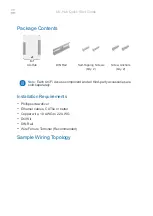
CHAPTER 11 SERIAL INTERFACE UART6
Preliminary User’s Manual U16898EJ1V0UD
196
(d) Continuous transmission
The next transmit data can be written to transmit buffer register 6 (TXB6) as soon as transmit shift register 6
(TXS6) has started its shift operation. Consequently, even while the INTST6 interrupt is being serviced after
transmission of one data frame, data can be continuously transmitted and an efficient communication rate
can be realized. In addition, the TXB6 register can be efficiently written twice (2 bytes) without having to wait
for the transmission time of one data frame, by reading bit 0 (TXSF6) of asynchronous serial interface
transmission status register 6 (ASIF6) when the transmission completion interrupt has occurred.
To transmit data continuously, be sure to reference the ASIF6 register to check the transmission status and
whether the TXB6 register can be written, and then write the data.
Cautions 1. The TXBF6 and TXSF6 flags of the ASIS register change from “10” to “11”, and to “01”
during continuous transmission. To check the status, therefore, do not use a
combination of the TXBF6 and TXSF6 flags for judgment. Read only the TXBF6 flag
when executing continuous transmission.
2. When the device is incorporated in a LIN, the continuous transmission function cannot
be used. Make sure that asynchronous serial interface transmission status register 6
(ASIF6) is 00H before writing transmit data to transmit buffer register 6 (TXB6).
TXBF6
Writing to TXB6 Register
0 Writing
enabled
1 Writing
disabled
Caution To transmit data continuously, write the first transmit data (first byte) to the TXB6 register.
Be sure to check that the TXBF6 flag is “0”. If so, write the next transmit data (second byte)
to the TXB6 register. If data is written to the TXB6 register while the TXBF6 flag is “1”, the
transmit data cannot be guaranteed.
The communication status can be checked using the TXSF6 flag.
TXSF6 Transmission
Status
0 Transmission
is
completed.
1
Transmission is in progress.
Cautions 1. To initialize the transmission unit upon completion of continuous transmission, be sure
to check that the TXSF6 flag is “0” after generation of the transmission completion
interrupt, and then execute initialization. If initialization is executed while the TXSF6
flag is “1”, the transmit data cannot be guaranteed.
2. During continuous transmission, an overrun error may occur, which means that the
next transmission was completed before execution of INTST6 interrupt servicing after
transmission of one data frame. An overrun error can be detected by developing a
program that can count the number of transmit data and by referencing the TXSF6 flag.
www.DataSheet4U.com
www.DataSheet4U.com
















































